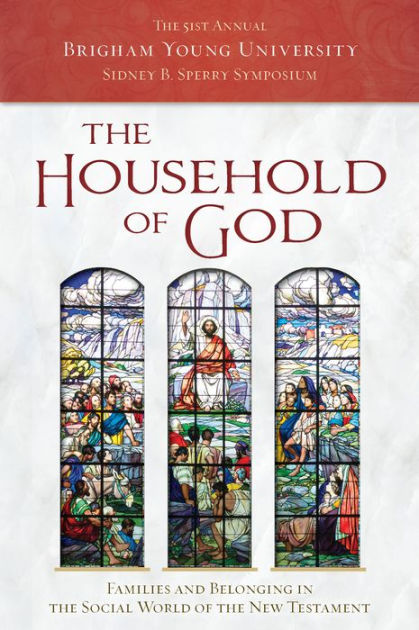
Review
======
Title: The Household of God—Families and Belonging in the Social World of the New Testament. The 51st Annual Brigham Young University Sidney B. Sperry Symposium.
Editors: Lincoln H. Blumell, Jason R. Combs, Mark D. Ellison, Frank F. Judd, Jr., and Cecilia M. Peek
Publisher: Religious Studies Center, Brigham Young University/Deseret Book
Genre: Sperry Symposium essays
Year Published: 2022
Number of Pages: Number of Pages: vii + 311
Binding: Cloth
ISBN: 978-1-9503-0434-9
Price: $25.99.
Reviewed by Sam Mitchell for the Association for Mormon Letters
In preparation for Latter-day Saints’ study of the Come, Follow Me New Testament curriculum in 2023, The Household of God seeks to contextualize different aspects of family and kinship life found in the New Testament. This volume is composed of essays that range on a spectrum from academic to devotional—for me (and, I assume, for most readers), this means that some essays resonate more particularly than others. While not a comprehensive examination of life in first-century CE Judea, The Household of God at the very least introduces Latter-day Saint readers to differences in culture, presentation, and family that they may be unfamiliar with as they read the New Testament.
Of especial note are several essays in the second half of the volume that deal with dynamics more pressing and immediate for Latter-day Saints today. Nicholas J. Frederick’s “Marriage, Divorce, and Remarriage in the New Testament World” (119–146) and Mark D. Ellison’s “The Inclusion of Sexual Minorities in the Family of God” (173–200) both discuss modern issues that are addressed to one extent or another by Jesus in the New Testament. Additionally, essays on polygamy (“‘Let Me Take Another Wife’: Israelite, Jewish, and Latter-day Saint Polygamy in Historical and Literary Perspective,” by Joshua M. Sears and Avram R. Shannon; pp. 147–172) and slavery (“Recognizing and Understanding Slavery in the New Testament,” by Andy Mickelson; pp. 201–224) are important reminders to Latter-day Saints that the world of the Bible is a place that can be very foreign and uncomfortable. (As a side note, these two essays were among my favorites in The Household of God.)
One unexpected but welcome essay was Byran B. Korth’s and Andrew C. Reed’s “Become as Little Children: Participating in the Household of God” (73–93). It too focuses on a usually marginalized group in the New Testament: little children. Its introduction of a “childist” perspective and its examination of Jesus’s two specific teaching episodes on little children offer a stepping-stone in utilizing this and other literary perspectives to examine scripture. (For instance, a future essay on how children are treated and used in texts like the Book of Mormon or the Doctrine and Covenants would be interesting sequels to this work). Jesus’s exhortations for his followers to become like little children are examined seriously and thoughtfully here, though I would have liked to have seen their implications extended to even a cursory glance of Jesus’s own incarnation as a baby in the infancy narratives. Despite that, I found this essay to be enjoyable and indicative of the many different ways that families and kinships can be observed and examined in the New Testament and other books of scripture.
For the most part, The Household of God tends to skew towards depictions of families and kinships in the Gospels, in Acts, and in some of the Pauline epistles. An exception is Matthew J. Bowen’s article on Jesus’s familial and priestly roles in the Epistle to the Hebrews (243–264). While further studies of the epistolary household codes and of patron-client relations in Revelation would have been useful inclusions, The Household of God is primarily interested in opening up this field of study to its readers, and as such, can only cover so much. An interesting and helpful chapter at the end of the volume is Lincoln H. Blumell’s and Frank F. Judd, Jr.’s “Additional Resources for Gospel Teachers” (265–279). Drawn from a variety of Church and BYU publications and statements, this chapter helps make the topics of The Household of God more accessible for a broad Latter-day Saint audience.
The inclusion of minority-centric essays—like those on slavery, polygamy, divorce, and children—was a brilliant step forward, and I hope that future symposia on this and similar topics will continue to emphasize topics that are not as theologically apparent as atonement or adoption, but whose cultural underpinnings are vital to understanding said doctrines. (Further discussions on slavery and women’s roles in house-church settings would, I think, be of great importance going forward, as would reviews of patron-client relationships in terms of grace, faith, and righteousness.) In all, The Household of God has something for everyone, ranging from the academic to the devotional, and it seeks to inspire a greater awareness of and for all members of the body of Christ today. I hope that this and other works will continue to increase New Testament literacy and awareness, especially as most Latter-day Saints begin to study from it once more this upcoming year.
